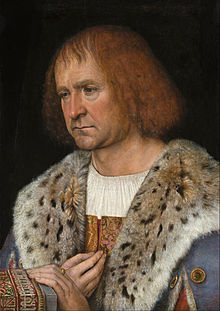Diego de Guevara

Don Diego de Guevara (c. 1450 – 1520) was a Spanish
Career
He was a younger son of Ladrón de Guevara, Lord of

He rose through the ranks of the ducal household, becoming chamberlain by 1501. He was first maitre d'hotel to Philip's wife, Queen Joanna of Castile (Joanna the Mad) when the couple travelled to Spain in 1506.[3] He was used as an ambassador, then usually an appointment for a relatively brief mission, to England and the court of Ferdinand II of Aragon. After Philip's death in 1506, Diego became councillor and chamberlain to Philip's son Charles V, Holy Roman Emperor.[3][7] Charles appointed him knight and warden (clavaría) of the Order of Calatrava in 1517,[3][8] and in 1518 Mayordomo mayor, an important role in charge of his personal apartments and arrangements.[citation needed]
Diego de Guevara died in Brussels on 15 December 1520.[9] He was a cousin of Antonio de Guevara,[8] and had at least one child, his illegitimate son Felipe (see below). It is possible that female relative of his lived in Netherlands with him. One of portraits by Master of Legend of Magdalene, shows lady in Netherlandish outfit and described as Marguerite (de) Guevara, lady in waiting to Eleanor of Austria.
Art collector
There are various references to works of art owned by him, and several well-known survivals.
Guevara's presumed portrait by his fellow courtier
His son also says he was in possession of a portrait of Diego painted by
Notes
- ^ Wolff, 232; the four "Dukes" include Mary as Duchess suo jure, and Charles V; Philip the Good, died 15 June, 1467, would make five.
- ^ a b Campbell, 192-193
- ^ a b c d e Wolff, 232
- ^ Campbell, 178 describes him as "brought up at the Burgundian court"; Notes 1 and 127 (quoted) on pages 204 and 207 give more details. See also the van der Weyden portrait mentioned below, which must have been painted by 1464 when the artist died.
- ^ Campbell, 192-193 and notes 124-129 on page 207. If he did so, he apparently did not see the job through, as other accounts say that it was three days before Charles' body was found and identified.
- ^ Campbell, 193
- ^ Hicks, Girl in a Green Gown, p. 45.
- ^ ISBN 9780820471327.
- ^ López Álvarez, Alejandro. "Diego de Guevara". Diccionario biográfico España (in Spanish). Real Academia de la Historia.
- ^ Hall, Edwin (1997). The Arnolfini Betrothal: Medieval Marriage and the Enigma of Van Eyck's Double Portrait. University of California Press. p. 2.
- ^ Campbell, 174, 192-193
- ^ Wolff, 230-231; Felipe's biography on the Spanish Wikipedia
- ^ Wolff, 230-231
- ^ Wolff, 231-232; the Berlin Madonna and Child
- ^ Wolff, 232-233; he is not convinced by the identification of Katherine of Aragon.
- ^ Prado, #s 2052, 2056; Brown, 61; they contradict each other about the date of the Haywain purchase, and maybe other details.
References
- Jonathan Brown: Painting in Spain, 1500-1700 (Pelican History of Art), Yale University Press, 1998, ISBN 0-300-06474-8
- Campbell, Lorne, The Fifteenth Century Netherlandish Paintings, National Gallery Catalogues (new series), 1998, LCCN 98-66510, (also titled The Fifteenth Century Netherlandish Schools)
- Hicks, Carola (2011). Girl in a Green Gown: The History and Mystery of the Arnolfini Portrait.
- Museo del Prado, Catálogo de las pinturas, 1996, p., Ministerio de Educación y Cultura, Madrid, ISBN 84-87317-53-7
- Wolff, M. in: J.O. Hand & M. Wolff, Early Netherlandish Painting, National Gallery of Art, Washington(catalogue)/Cambridge UP, 1986, ISBN 0-521-34016-0, Google books
